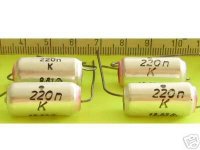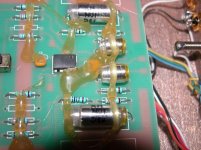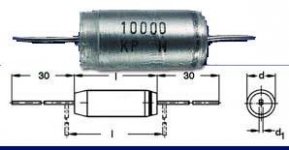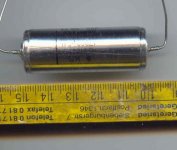I've just purchased some 0,22uF polystyrene (styroflex) capacitors and I was wondering if they can be suitable for decoupling the TDA1541A.
I've already placed an order for Wima MKPs (0,1 uF).. are these better or should I stick with the Wimas?
Cheers
Andrea
I've already placed an order for Wima MKPs (0,1 uF).. are these better or should I stick with the Wimas?
Cheers
Andrea
Attachments
Peter,Those are the caps smilar to ones used in Grado phono stage for RIAA. I don't think they sourced them in DDR?
those caps on your photo look like to be real Styroflex (KS) caps whereas those shown at Andrea`s pic though looking very similar indeed look like sourced from DDR. They`re probably not Styroflex but some kind of lower quality Polyester film caps.
BTW: sourced from DDR does not mean automatically low quality - they have had their good stuff also.
Polyester 220nF 2.5cm long? Hardly.cocolino said:
Peter,
those caps on your photo look like to be real Styroflex (KS) caps whereas those shown at Andrea`s pic though looking very similar indeed look like sourced from DDR. They`re probably not Styroflex but some kind of lower quality Polyester film caps.
BTW: sourced from DDR does not mean automatically low quality - they have had their good stuff also.
Andypairo said:I've just purchased some 0,22uF polystyrene (styroflex) capacitors and I was wondering if they can be suitable for decoupling the TDA1541A.
I've already placed an order for Wima MKPs (0,1 uF).. are these better or should I stick with the Wimas?
Aren't the typical styrene caps (not those MITs) wound with a geometry that gives a rather high inductance? If so, wouldn't those caps be far more useful as an audio coupling and/or filtering application rather than a digital/ps decoupling application where that inductance would be probemattic?
Styroflex has low dielectric constant which means they sound good but are big.
Some people especially those who sell stuff on ebay call everything styroflex that looks like the caps in your pictures.
Those with wires sticked into foil are inductive.
The type with wires bond to the end s of the roll are better.
Happy styroflexing !
Some people especially those who sell stuff on ebay call everything styroflex that looks like the caps in your pictures.
Those with wires sticked into foil are inductive.
The type with wires bond to the end s of the roll are better.
Happy styroflexing !
Bernhard said:Styroflex has low dielectric constant which means they sound good but are big.
Some people especially those who sell stuff on ebay call everything styroflex that looks like the caps in your pictures.
Those with wires sticked into foil are inductive.
The type with wires bond to the end s of the roll are better.
---------------------------------------------------------------------------------
How does one tell whether the wires are stuck or welded, especially where they are encapsulated?
I thought polystyrene just melts if you try to weld.
fmak said:
How does one tell whether the wires are stuck or welded, especially where they are encapsulated?
I thought polystyrene just melts if you try to weld.
Open them.
No idea how they do it but they do it.
KS or not KS, this is the question:
Pedja,
You`re probably right, sorry I did not notice the measure in the picture.
OTOH when You have seen 220nF caps the last time? Styroflex caps usually are not avaiable in such big values (mostly 47nF is the biggest value) and when this ones are high voltage types (250V or more) they are likely what I stated, Polyester.
Anyway, there should be caution though when buying those kind of caps. I once bought a bunch at a surplus clearout sale. They were advertised as KS caps but most of them where Polyester not KS although they looked almost the same. Some of them had even printed MKT on them. When You see those with values of 220nF (and sometime even more) and rated for >250V You can be almost sure that this are not KS caps even when they are is big as the ones we`re talking about.
Therefore I can only second what Bernhard said:

Originally posted by Pedja
Polyester 220nF 2.5cm long? Hardly.
Pedja,
You`re probably right, sorry I did not notice the measure in the picture.
OTOH when You have seen 220nF caps the last time? Styroflex caps usually are not avaiable in such big values (mostly 47nF is the biggest value) and when this ones are high voltage types (250V or more) they are likely what I stated, Polyester.
Anyway, there should be caution though when buying those kind of caps. I once bought a bunch at a surplus clearout sale. They were advertised as KS caps but most of them where Polyester not KS although they looked almost the same. Some of them had even printed MKT on them. When You see those with values of 220nF (and sometime even more) and rated for >250V You can be almost sure that this are not KS caps even when they are is big as the ones we`re talking about.
Therefore I can only second what Bernhard said:
Recently I saw somebody offering 0,68µF KS caps - they were ROE .....MKT (of course) - I told the seller about this ....he said thanks........but did not change his descriptionSome people especially those who sell stuff on ebay call everything styroflex that looks like the caps in your pictures.
Re: KS or not KS, this is the question:
Apart from the ones with MKT printed on them, how did you understand they were polyester?
Cheers
Andrea
cocolino said:
Pedja,
You`re probably right, sorry I did not notice the measure in the picture.
I once bought a bunch at a surplus clearout sale. They were advertised as KS caps but most of them where Polyester not KS although they looked almost the same. Some of them had even printed MKT on them.
Apart from the ones with MKT printed on them, how did you understand they were polyester?
Cheers
Andrea
For me there is no way other as to measure dissipation factor on a high performance digital LCR bridge at different frequencies. Real KS caps have dissipation factors towards zero whereas Polyester caps are much worse.Apart from the ones with MKT printed on them, how did you understand they were polyester?
I did not know until recently myself that this type of caps might not be KS. Somebody told me and I went on to measure them .....since this I know that not everything is KS what looks alike.
BTW: attached a picture of a real high voltage KS cap (this ones are rare!). Only that You get a picture of how big those things are when they are real (this one is 47nF/630V).
Therefore I said when the 220n from Your picture is something around 250V or above rated they`re likely not KS even when they are 2,5cm long. In case they are "low voltage" rated (63V) it might be that they are KS indeed (but somehow I don`t believe it though).
Attachments
Originally posted by Bricolo
Are those original styroflex caps?
It`s hard to tell from this picture with certainty but I`m inclined to claim that this are original Siemens KS.
Cocolino,cocolino said:Pedja,
You`re probably right, sorry I did not notice the measure in the picture.
OTOH when You have seen 220nF caps the last time? Styroflex caps usually are not avaiable in such big values (mostly 47nF is the biggest value) and when this ones are high voltage types (250V or more) they are likely what I stated, Polyester.
Anyway, there should be caution though when buying those kind of caps. I once bought a bunch at a surplus clearout sale. They were advertised as KS caps but most of them where Polyester not KS although they looked almost the same. Some of them had even printed MKT on them. When You see those with values of 220nF (and sometime even more) and rated for >250V You can be almost sure that this are not KS caps even when they are is big as the ones we`re talking about.
If they are from Eastern Germany, then they are at least 15 years old. Quite easily the number 81 that can be seen in the pic posted by Andrea (on the one cap, 83 on the other, if I see this well) might be the year of production.
Rel-cap is/was making styrenes in the values up to 1.5uF. I am just looking one catalogue that says 150nF/100V RTX styrene is 2.5cm long.
As about the other things you have said, yes, the man should be very careful with sellers of such things.
Pedja
Pedja, you are right, the caps were made around 1980.
Today I dismantled a dented one and can say (no photos tough) that is (quite obviously) made of two metal sheets rolled together with in between the styrene dyelectric. The pins are quite bold and not exactly on the axis of the cap but rather on the middle point of the armatures for constructive reasons.
The risk was minimal, I paid less than 10€ (including transport which was about 5) for 25 of these (well.. 24 now ) and 25 1,5 nF... anyway I tend to believe they are genuine.
) and 25 1,5 nF... anyway I tend to believe they are genuine.
The question is: are such caps any better than MKPs?
Cheers
Andrea
Today I dismantled a dented one and can say (no photos tough) that is (quite obviously) made of two metal sheets rolled together with in between the styrene dyelectric. The pins are quite bold and not exactly on the axis of the cap but rather on the middle point of the armatures for constructive reasons.
The risk was minimal, I paid less than 10€ (including transport which was about 5) for 25 of these (well.. 24 now
The question is: are such caps any better than MKPs?
Cheers
Andrea
Andypairo said:The question is: are such caps any better than MKPs?
The answer to your question is very simple: Just put them in a circuit and listen. Nobody will tell you better
- Status
- This old topic is closed. If you want to reopen this topic, contact a moderator using the "Report Post" button.
- Home
- Source & Line
- Digital Source
- Styroflex caps for TDA1541A decoupling?



